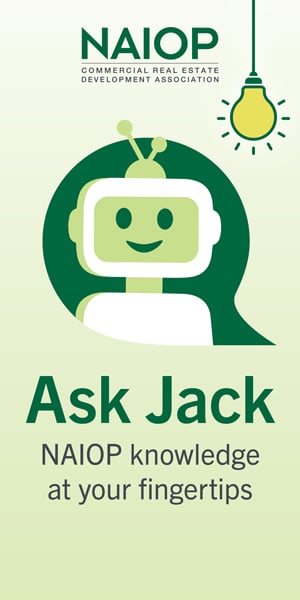The Future of the Office is Healthier, More Engaging Spaces

Building owners will need to innovate to keep workers coming back.
As the world emerges from the COVID-19 pandemic, the success and popularity of remote work could force many companies to reduce their office footprints. That, in turn, will require building owners to find new ways to make their properties more relevant and valuable, particularly in urban cores.
A recent webinar for NAIOP members explored strategies that developers can pursue to draw workers back to the office.
A Focus on Health
According to Ian Zapata, design director for Gensler, the pandemic has put the health of existing buildings — and particularly their access to clean, fresh air — at the top of everyone’s minds.
“It’s no surprise that we’re now much more conscious of things like the air we breathe and our surroundings, the impact of the built environment has on our health,” he said during the webinar.
Zapata said that prior to the pandemic, the cost of anti-pathogen HVAC systems, environmental controls and indoor air quality monitoring would be difficult to justify in an office building, but that is changing.
“These investments can now be marketed as a building differentiator,” he said.
The quality of outdoor space is also important, Zapata said, and it extends beyond just setting up outdoor meeting areas.
“We believe that buildings that have access to outdoor space will have a clear advantage in this new landscape,” he said. “Spaces should be thoughtfully programmed or designed so they can be higher performing.”
Mixed-use environments can also be a critical part of development strategies. Because the pandemic has normalized flexibility for work, building populations will fluctuate more than they used to. Therefore, owners will need to attract a wider range of tenants than they did in the past.
Zapata said flexibility will be a key feature for real estate going forward. That focus on flexibility can extend to a company’s entire real estate portfolio. Zapata said the traditional paradigm of a certain type of tenant for the suburbs and a certain type of tenant for the central business district might be changing as companies take a broader view of where they distribute their real estate.
“Many companies are rethinking their real estate strategy, abandoning centralized operations in favor of a distributed model, which in turn allows workers to have more choice in where they live, where they raise their families and the length of their commutes,” he said. “Having that flexibility by providing that choice for employees is one potential bright side to come out of the pandemic.”
Noting the longstanding influence of hospitality on real estate, Zapata said building owners need to accelerate that trend in the aftermath of the pandemic as workers yearn to reconnect with people and places they haven’t seen in months. And to attract a wider range of tenants than before, he recommends developers invest in multi-use spaces.
“That means being part of a broader community in an activated street scene,” he said. “We took this for granted, but the pandemic reminded us that a big reason people go to the office is to interact with other people socially.”
Personalized service and convenience offerings will also increase because people got used to the ability to work and take care of personal business at the same time. And finally, memorable, aesthetically pleasing place experiences will be another crucial factor that will draw workers back to offices, Zapata said.
“This notion of a generic office building that is measured purely and solely on its efficiency of space per square feet per person, I think it’s less relevant in an age where people need to be excited about coming into the office and making that choice to come into the office,” he said.
The Morphable Office
Duncan Lyons, a design director with Gensler, described a new model for office development that the company is calling the morphable office. According to Lyons, the concept began as a research project in partnership with Arup and evolved into a design speculation for a site in Baltimore.
Instead of a site that maximizes density, the design concept sets the building back and creates a linear park along a street to the east of the project. The building would be constructed in a way that allows the public space to extend under it, with ground-floor programs that support the local community.
The morphable office space exists on the upper floors. Each floor has an offset core and a 200-yard exterior walking loop around the perimeter of the building. The south and east facades are movable walls that can slide open as the floor morphs from 30% to 50% open to create outdoor collaboration and theme space. It can flex from indoor to outdoor space depending on the weather conditions.
Residents share a rooftop terrace, and a vertical garden that climbs the side of the building to the roof extends the ground-floor linear park.
“You can see how much this space really feels connected to nature and to the city around it,” Lyons said. “It has a really strong sense of place and a really strong sense of well-being for the office tenants.”
In terms of energy efficiency, the design concept would use radiant flooring to heat and cool the space. It would also reduce embodied carbon by 15% by using reclaimed wood and carbon cure concrete, a technology that injects carbon dioxide into concrete to permanently embed it. Additionally, the building would feature photovoltaic panels on the roof to generate power, resulting in 50% less energy usage than a traditional office.
“But the real market differentiator is actually a whole new kind of office that allows tenants to sit, stand and work while moving through sheltered, tempered outdoor space, all while having access to fresh air while being able to connect to the community,” Lyons said.
As far as costs, Lyons said contractors are conducting preliminary pricing on the research project, but he noted that it’s basically a concrete structure —with a few differences.
“There’s nothing unusual about it,” he said. “There’s a largely glass façade which is operable on two sides and closed on two sides, so there is a cost premium for façade operability, but we think it’s not a significant premium.”
Lyons said Gensler is rolling out this concept to its developer clients, and the firm is already designing projects in Washington, D.C., and Los Angeles that incorporate many of these features.
Trey Barrineau is the managing editor of publications for NAIOP.
|
Five Factors Affecting the Success of Cities What serves as the foundation for a great city? For its most recent City Pulse Survey, Gensler surveyed 5,000 urbanites in 10 cities around the world in early 2021 to measure these residents’ attitudes as the world approached one year of living with COVID-19 and mass vaccinations began in many countries. The findings were shared by Sofia Song, global cities lead with Gensler, during a recent webinar for NAIOP members. The survey results showed that 28% of the respondents were likely to move out of their city soon, as urban living satisfaction continues to decline. Those who can work remotely were 11% more likely to consider moving than those who do not have the opportunity to work remotely. The increasingly hybrid/remote global workforce does not signal the end of cities or central business districts, however. Regardless of the size of their current city, over two-thirds of survey respondents who were considering moving said they wanted to relocate to a smaller, less populated location — including smaller cities, suburbs or rural areas. Gensler identified five factors (both positive and negative) that influence people’s decision to stay in or leave their current city. Three factors motivating people to stay in cities are: Great neighborhood design. “People who feel that their neighborhoods are beautiful, authentic, safe, clean, and pedestrian-friendly are more likely to want to stay in their current cities.” Employment opportunities. “When it came to employment opportunities, we found that people need both job options and opportunities for career advancement.” Transportation options. “Cities should take a multimodal approach to foster a seamless mass transit experience — one that not only accommodates cars but also integrates micro-mobility options.” Two factors that drive people to leave big cities: “Big city” problems. “People who feel that their cities are too big, too noisy, too crowded, have too much traffic, and are losing their cultural heritage are more likely to consider relocating. Over half of urban residents feel that their cities are too crowded, which could become a key concern after the population crowdedness issues raised by the pandemic.” Affordability. “People who are living paycheck to paycheck, who feel that their neighborhoods are becoming increasingly unaffordable, and who feel the anxiety from these stressors, are much more likely to consider leaving. This is especially true in rising cities like Atlanta, Austin, and Denver, where they experienced an influx of new city residents.” By Brielle Scott, senior communications manager at NAIOP. |




